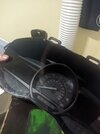Kovansky
New Member
Greetings to all,
In advance I want to mention that my English is not very good so sorry if you don't understand everything.
I currently have a Speedometer from a 2018 Ford Edge, which I want to get working.
When you power it with 12V it doesn't work, this is because (as far as I understand) it is waiting for a CAN message to start up.
Unfortunately I have not been able to find any CAN messaging service on the internet that can do it.
I currently own a 2013 Ford Edge SEL V6 AWD.
So I decided to use my Edge to read all the data from the CAN bus and from there separate everything I can (I'm relatively new and I'm learning how all this works, I'm only an electronics technician).
The problems I am having when reading the CAN bus of my vehicle are the following.
Problem #1 - First device:
CAN to USB-C (CANABLE) using the PCAN-View software
When connecting the device to the CAN network, the vehicle shows many errors in the ODO and then the EDGE shut off a few seconds later, (it does nothing until i disconnect the CANABLE device from the CAN network and remove and reincert the key).
Watch video to understand better.
Problem #2 - Second device:
Clone of Arduino UNO and CAN BUS SHIELD.
With this I can see something of the CAN network but nothing close to the screenshots that you show in this forum.
I would like to know what I am doing wrong? I want to be able to read the CAN BUS data, an example is the video that pyrocrazy130 uploaded (Bo Gifford - Ford CAN bus hacking, comment #20) on this forum)
https://drive.google.com/drive/u/0/folders/1i2J3tV6eE-K8bA-D6dOocOT7jBDU7269 (pics, videos and more info of the device)
--> Update
After trying various configurations with the CAN to USB-C (canable), I managed to get the vehicle to not show the errors shown in the video "Problem #1 - First device" and to turn on without problems
In advance I want to mention that my English is not very good so sorry if you don't understand everything.
I currently have a Speedometer from a 2018 Ford Edge, which I want to get working.
When you power it with 12V it doesn't work, this is because (as far as I understand) it is waiting for a CAN message to start up.
Unfortunately I have not been able to find any CAN messaging service on the internet that can do it.
I currently own a 2013 Ford Edge SEL V6 AWD.
So I decided to use my Edge to read all the data from the CAN bus and from there separate everything I can (I'm relatively new and I'm learning how all this works, I'm only an electronics technician).
The problems I am having when reading the CAN bus of my vehicle are the following.
Problem #1 - First device:
CAN to USB-C (CANABLE) using the PCAN-View software
When connecting the device to the CAN network, the vehicle shows many errors in the ODO and then the EDGE shut off a few seconds later, (it does nothing until i disconnect the CANABLE device from the CAN network and remove and reincert the key).
Watch video to understand better.
Problem #2 - Second device:
Clone of Arduino UNO and CAN BUS SHIELD.
With this I can see something of the CAN network but nothing close to the screenshots that you show in this forum.
I would like to know what I am doing wrong? I want to be able to read the CAN BUS data, an example is the video that pyrocrazy130 uploaded (Bo Gifford - Ford CAN bus hacking, comment #20) on this forum)
https://drive.google.com/drive/u/0/folders/1i2J3tV6eE-K8bA-D6dOocOT7jBDU7269 (pics, videos and more info of the device)
--> Update
After trying various configurations with the CAN to USB-C (canable), I managed to get the vehicle to not show the errors shown in the video "Problem #1 - First device" and to turn on without problems
Attachments
-
 Arduino UNO and CAN BUS SHIELD-1.jpg1.7 MB · Views: 470
Arduino UNO and CAN BUS SHIELD-1.jpg1.7 MB · Views: 470 -
 Arduino UNO and CAN BUS SHIELD-2.jpg3 MB · Views: 387
Arduino UNO and CAN BUS SHIELD-2.jpg3 MB · Views: 387 -
 Arduino UNO and CAN BUS SHIELD-3.jpg3.9 MB · Views: 381
Arduino UNO and CAN BUS SHIELD-3.jpg3.9 MB · Views: 381 -
 CAN to USB-C (CANABLE) - 1.jpg3.5 MB · Views: 441
CAN to USB-C (CANABLE) - 1.jpg3.5 MB · Views: 441 -
 CAN to USB-C (CANABLE) - 2.jpg2.9 MB · Views: 351
CAN to USB-C (CANABLE) - 2.jpg2.9 MB · Views: 351 -
 Speedometer-1.jpg2.5 MB · Views: 381
Speedometer-1.jpg2.5 MB · Views: 381 -
 Speedometer-2.jpg2.5 MB · Views: 462
Speedometer-2.jpg2.5 MB · Views: 462



